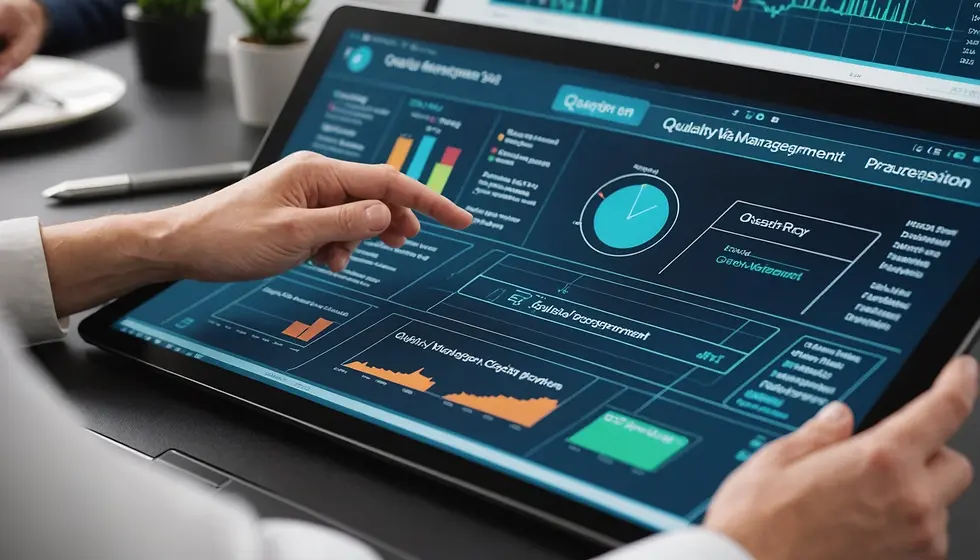Crafting an Effective ISO 9001 Communication Plan for Quality Management Implementation
- islam Arid

- Sep 23
- 5 min read
Implementing ISO 9001 can radically improve how organizations manage quality. A well-designed communication plan is essential for navigating this process. It keeps everyone informed and engaged, making the implementation journey smoother. In this blog post, we will discuss how to create an effective communication strategy specifically for ISO 9001 implementation.
Understanding the Importance of Communication in ISO 9001 Implementation
Communication is the backbone of successful ISO 9001 implementation. It helps connect management, employees, suppliers, and customers, ensuring that everyone understands the goals and benefits of a quality management system (QMS).
When organizations build a transparent and engaging culture, they see a boost in employee commitment. For example, a study indicated that organizations with strong internal communication achieve 47% higher total returns to shareholders compared to those with weaker communication strategies.
Key Elements of an ISO 9001 Communication Plan
A solid ISO 9001 communication plan includes several key elements which help clarify messaging, identify target audiences, and determine communication methods and frequency.
1. Identify Stakeholders
The first step is recognizing your stakeholders. These range from management and employees to suppliers and customers. Each group has its own unique information needs.
Management: Focused on performance metrics, compliance, and strategic alignment.
Employees: Need practical information about how changes impact their daily work.
Suppliers: Interested in how the QMS affects their quality expectations.
Customers: Seek assurance that products will meet high-quality standards.
For instance, recent surveys indicated that 70% of employees felt more engaged in environments where they clearly understood how their roles contributed to organizational goals.
2. Define Communication Objectives
Clearly defined communication objectives are crucial. They should focus on what you want to achieve throughout the ISO 9001 implementation.
Examples include:
Raising awareness of ISO 9001 standards among staff.
Educating employees on how to apply quality policies.
Promoting a culture of continuous improvement.
Ensuring everyone complies with ISO 9001 requirements.
Companies that set clear objectives are 12 times more likely to be successful in achieving their communication goals.
3. Choose Communication Channels
Different audiences respond better to different methods. Selecting the right channels for communication can make a significant difference.
Common channels for ISO 9001 communication include:
Emails: For formal updates and important notifications.
Intranet Portals: A central hub for sharing documents and updates.
Meetings: Foster discussions about ISO 9001 processes.
Workshops and Training: Provide hands-on, practical learning.
Utilizing a mix of channels helps meet varied preferences and enhances engagement.
4. Develop Key Messages
To effectively engage your target audiences, craft clear and concise messages that resonate with each group. The messages should address the relevance of ISO 9001 to them and how they contribute to the quality objectives.
Examples of key messages include:
For management: "ISO 9001 will improve our decision-making processes and increase customer satisfaction."
For employees: "Your contributions to ISO 9001 will empower you to drive meaningful change in our quality culture."
By tailoring messages, organizations see improved clarity and involvement, resulting in a motivated workforce.
5. Establish a Communication Timeline
A structured timeline outlines when and how often information will flow. Aligning this with project phases during ISO 9001 implementation provides clarity for all parties involved.
Setting specific dates for training or feedback sessions ensures that everyone is on the same page. For instance, sharing progress updates monthly helps maintain momentum and visibility.
6. Implement Feedback Mechanisms
Communication must be a two-way street. Establish opportunities for stakeholders to provide feedback about the ISO 9001 process.
Methods for gathering feedback might include:
Surveys: Assess employee understanding of the ISO 9001 initiatives.
Focus Groups: Host discussions to explore specific ideas and concerns.
Open-door Policies: Encourage informal chats about ISO 9001 implications.
Organizations that actively seek feedback can enhance their processes and maintain alignment with stakeholder needs.
7. Monitor and Adjust the Communication Plan
Regularly reviewing the communication plan is crucial. Keep track of engagement levels and feedback to adapt your strategies as needed.
Making adjustments based on insights strengthens the implementation process. For instance, if feedback indicates that employees are unclear about a policy, revisiting training sessions or communications can help clarify expectations.

Integrating Communication with Training and Development
Linking communication with training boosts the chances of successful ISO 9001 implementation. Engaging employees during training ensures they understand how to apply new information effectively.
Importance of Training in ISO 9001
Training is vital in building a quality-focused culture. Organizations should conduct ongoing training sessions covering:
ISO 9001 Overview: Introduction to the standard and its significance.
Quality Policies and Procedures: Discussions tailored to the organization's specific procedures.
Risk Management and Compliance: Strategies for identifying risks and maintaining compliance.
A 2022 study found that organizations investing in quality training see a 30% increase in overall productivity.
Engaging Leadership in Quality Communication
Leadership involvement is essential for a successful ISO 9001 implementation. Leaders set the stage for communication and emphasize the importance of quality management.
Leadership Communication Strategies
Leaders can enhance communication using the following methods:
Leading by Example: Showing commitment to quality and fostering open dialogue with staff.
Sharing Success Stories: Celebrating achievements related to ISO 9001 to inspire others.
Open Forums: Providing opportunities for employees to discuss quality matters with leaders.
When leaders prioritize effective communication, they instill a culture of accountability and transparency, encouraging better collaboration.
Evaluating Success through Performance Metrics
To assess the effectiveness of the ISO 9001 communication plan, organizations should create performance metrics aligned with their objectives. These metrics illuminate how well information is being shared and understood across the board.
Examples of Performance Metrics
Consider these practical metrics:
Employee Engagement Levels: Surveys that assess comprehension and satisfaction with ISO 9001 communications.
Training Completion Rates: Tracking employee participation in ISO 9001 training initiatives.
Feedback Responses: Monitoring both the quantity and quality of stakeholder feedback to identify improvement areas.
By regularly analyzing these metrics, organizations can refine their communication methods.
Cultivating a Quality Culture
Creating a strong culture around quality requires integrating ISO 9001 principles into daily practices and communications.
Strategies for Building a Quality Culture
Continuous Improvement Initiatives: Encourage employees to identify process improvements and share suggestions.
Recognition Programs: Implement systems to honor individuals or teams contributing to quality enhancement.
Regular Communication Updates: Maintain focus on initiatives, successes, and lessons through consistent messaging.
Fostering a quality culture turns ISO 9001 from a compliance checkpoint into an integral aspect of organizational identity.
Final Thoughts
An effective ISO 9001 communication plan is vital for successfully implementing a quality management system. Organizations can create a culture of quality and collaboration by understanding stakeholder needs, establishing clear objectives, choosing appropriate communication channels, and encouraging feedback.
As more organizations pursue ISO 9001 certification, prioritizing effective communication will lead to greater compliance, improved customer satisfaction, and efficient business processes. Embracing these principles transforms the approach to quality management, paving the way for lasting success.























Comments